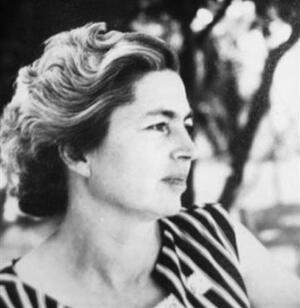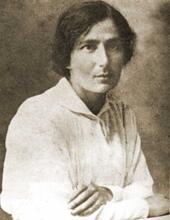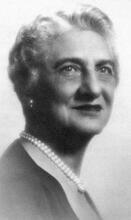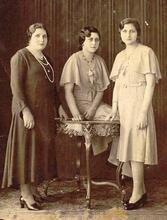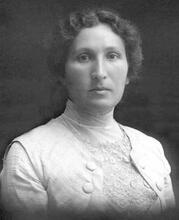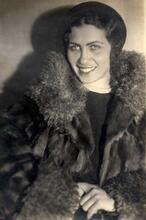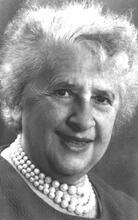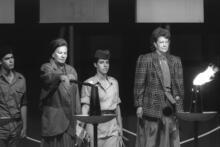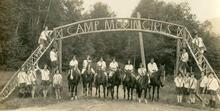Shulamit Goldstein
While Shulamit Goldstein is distinguished as Israel’s first female pilot, the arc of her life was hardly linear. Born in Ukraine, she made Aliyah with her family at age nine. After high school she joined Irgun, a secret militant group advocating for a free Jewish state, and at the group’s encouragement traveled to Egypt to learn to fly. She then returned to Israel and started studying to become a teacher. After marrying Dr. Rudoplh Goldstein, the couple began a poultry farm. They moved to Cyprus, where she ran the largest hatchery in the Middle East. She later created a workshop in Cyprus building fiberglass boat parts and chicken hatcheries. After her husband’s death, Goldstein returned to Israel, where she taught English.
Family and Education
Shulamit Gorengut was born on January 17, 1914, in Yampol, Ukraine, to Zionist, Hebrew-speaking parents. Her father, Azriel Gorengut (or Horengut, later Goren, who was born in Yampol in 1888 and died in 1974) was the official rabbi in Kremnitz, while her mother, Pnina (née Rosenblit, b. Yampol 1889, d. 1954), studied dentistry and worked as a dentist while still in Ukraine. In 1923, when Shulamit was nine years old and her brother Jacob (1918–1994) was five, the family emigrated to Palestine, where they lived in Haifa. Azriel worked as a bookkeeper at the Nesher cement factory, while his wife continued to work as a dentist, traveling to Jenin (1924–1929), where she spent several nights a week before returning home. One day a patient of hers warned her not to come any longer, since there were rumors that Jews would be killed. Ceasing her work there, she took a job as dentist at the Rutenberg Electric Works at Naharayim, before opening her own practice in the family’s home on Yehiel Street in Haifa.
Shulamit studied at the Reali School but completed her studies at the Technion High School (later Basmat). While still at school she and her brother joined the Betar Youth Movement. The movement was not popular in Haifa and the siblings frequently found themselves in conflict with the Ha-Koah group, emerging from the fights bruised and beaten. On completing high school Shulamit joined the Irgun Zeva’i Le’ummi (I.Z.L.).
Becoming a Pilot
In 1932 her parents moved to Pardess Hannah, where her mother opened two dental clinics, one in the Lit. "village." The dominant pioneer settlement type of the Jews in Palestine between 1882moshavah and one at home, while also driving on a donkey-drawn wagon to practice in the villages of Wadi Ara. Her father became a citrus grower. At this time, Shulamit met Avishalom Drori, who was also an I.Z.L. member, and in 1934, with the encouragement of the I.Z.L., the two went to Egypt to learn flying. The studies at the Misr Airwork Flying School were funded mainly by Shulamit’s parents and by activities in the Jewish community, where Shulamit sang Hebrew songs, accompanied on the guitar by Avishalom. In an article published in December 1935, the Egyptian Aviation Review reported that “There are many Jewish airmen, but not one Palestinian. Almaza Flying School is therefore very proud of bringing out the first Palestinian man and lady pilot, Mr. Avishalom Drori and Miss Shulamith Goringoot, who are under instruction.”
The officer in charge of the flying school was Captain Sabar Halil al-Kassaf and the instructors were Lutfia al-Naddi, the first Egyptian woman pilot, and Shafik Nasi, the first Egyptian instructor. Throughout the two years of study Shulamit took an active part in the life of the country’s Jewish community. The presence at the school of Palestinian-Jewish students was also criticized by the Egyptian newspaper Aliwa, in which Hajj Amin al-Husseini published an editorial on the visit to Egypt of Moshe Shertok (later Sharett). Among other things, he warned the Egyptians to avoid danger and not fall into the Jews’ net. He also wrote: “We don’t know the outcome of the visit, but Mr. Shertok traveled to Egypt on business connected with the (Jewish) ancestral home. And that is sufficient to arouse Egyptian attention, since the activities of Mr. Shertok and his colleagues in other areas are connected with military ambitions. After all, a young Jewish man and woman trained in the skill of flying at the Egyptian Flight Station and then returned to Tel Aviv to found the flying club there, in the framework of which a group of Egyptian pilots flew to Palestine” (cited in Davar, Issue 57, 14 Tevet 5694 [January 1, 1934]).
On January 20, 1936, five planes flew from the school to Palestine. Shulamit flew in one, together with Captain Sabar Halil al-Kassaf. Although they planned to land at Lydda, weather conditions compelled them to land at the military airfield in Ramallah.
On completing the course, Shulamit returned home and joined the Betar Work Brigade in Rosh Pinnah. Her marriage to Avishalom Drori was not successful and they divorced a year and a half after the birth of their daughter Aya (Leibowitz) in 1936.
Teaching and Farming
In 1940 Shulamit began studies at the Teacher Training College in Tel Aviv and on completing her studies in 1942 began work as a nursery school teacher in Givat Adah. At this time she met Dr. Rudolph (Rudi) Goldstein, a lawyer and chemist who worked in Binyaminah manufacturing soap and plant essences (salvia, acacia, and valerian root) for export. When they married in 1942, Shulamit moved to Binyaminah, where she taught the local children, among them such later famous figures as Ehud and Yirmi Olmert, Ehud Manor, Shlomo Gravitz, Ze’ev Boim and Menahem Peri. She bore two daughters: Michal Palgi (b. 1944) and Dina Teff (b. 1947).
In 1948 Shulamit and Rudi decided to establish a small poultry farm. Rudi specialized in this field, soon becoming the Ministry of Agriculture’s chief instructor in poultry raising in the northern region. In consequence, Shulamit herself ran the family business, which had meanwhile grown, while also continuing to work at the nursery school.
In 1957 Rudi’s work led the family to move to Cyprus, where Shulamit headed the largest hatchery in the Middle East, Bellapais Hatcheries, which exported 100,000 chicks a month to all the Mediterranean countries.
In 1959 Shulamit developed a new area of expertise. Rudi’s hobby was sailing and she decided to cover his boat with fiberglass. In order to do so, she returned to Israel to study the craft of fiberglass covering at the Makhteshim factory. Returning to Cyprus, she opened a workshop that built catamarans of fiberglass and also manufactured roofs for all the chicken runs and hatcheries, to replace their asbestos roofs.
In 1968, while they were in the process of returning to Israel, Rudi died and Shulamit returned alone. She taught English at the agricultural school in Pardess Hannah and volunteered at giving Hebrew lessons to new immigrants. She spoke six languages: Hebrew, Russian, Arabic, English, German, and Greek.
Shulamit Goldstein passed away on July 12, 2011, and was buried in Binyaminah.
“Biographies, Gorngut-Goldstein Shulamit (Hornhut Shulamit).” Jablonsky Institute in Israel Archive. Reference code K25-3/45.
Kadesh, Avigayil. “Israeli women get their own museum.” Israel Ministry of Foreign Affairs. October 23, 2012. https://mfa.gov.il/MFA/IsraelExperience/Pages/Museum-of-Israeli-women-23-October-2012.aspx

